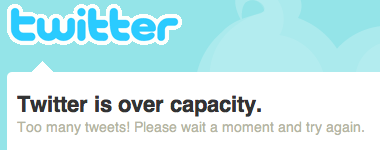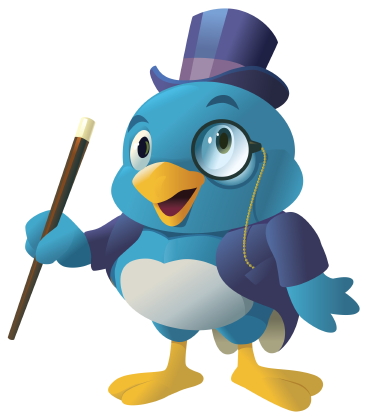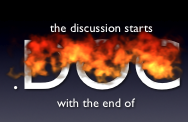How 1.5 is Greater than 2.0
I found Tom Davenport's discussion of Why 1.5 is Greater than 2.0 by way of Bill Ives in Mixing Old and New School Communication. Davenport talks about the social reasons in favor of a blend between social and traditional approaches. I think an answer to How 1.5, in this context, is Greater than 2.0 is both social and structural.
What's Social About Software? And Why It Matters.
Innovation starts with words, and ways to convey them.
Having versus Using Enterprise 2.0 Software

Gil Yehuda wrote a very good post today Enterprise 2.0 Thoughts to end the week. He talks about Enterprise 2.0 maturity, second wave adoption, focus on work, and levels of the conversation. It's a great post you should read in full and reflect on. One particular point caught my attention; Gil says: "... having a wiki, forum, blogs, etc. on the intranet and using a wiki, forum, blog effectively to improve the transparency and productivity of collaboration are very different indicators of progress."
Andy Keller talks about Traction's use of GWT | Video
May 12, 2009 5:38pm rotkapchen Great explanation: Traction Director of Engineering Andy Keller tells why Traction's chose GWT (Google Web Toolkit) for TeamPage's new interaction layer. View video inline below or youtube.com/watch…
#E2L09 Innovation Starts with Ideas. Wiki will Cross the Work 2.0 Frontier When TeamPage 5.0 Carries Ideas into Action.
These case studies are a taste of how ideas and issues turn into action, how tasks evolve from conversations and how boundaries have to appear to disappear for W2.0 ideas to meet E2.0 execution. See you at E2.0.
Can't stuff the Web back in a box ...

On April 16 2009 Oliver Marks wrote The CIA's Collaboration Growth Curve & IBM's Lotusphere ecosystem connecting three topics: 1) the transformation of the CIA's collaborative practices; 2) how this relates to the concept of the collaboration curve introduced by John Hagel III, John Seely Brown (JSB), and Lang Davison, and 3) his reaction to IBM's Lotusphere Comes to You roadshow event in San Francisco that day. It's a great post which motivated me to add a comment which I expanded a bit below.
re: Explaining Twitter - One of Three Places for People
Rafe WTF of the day: @Josh comes back from lunch... "I got some cat food, do you want it?" Twitter.com 4:13PM 15 Apr 2009 ... much funnier than my example, but QED.
Enterprise 2.0 and the importance of Silo Smashing!

Recent posts by Michael Sampson, John Tropea and Thomas Vander Wal converge on the need for Enterprise 2.0 tools to smash the silos segregating content types and isolating workspaces.
Mixing Tasks and Conversations, and KUKA as the "seminal enterprise 2.0 solution"
A tweet from John Tropea identifies our Kuka Systems case study as the "Seminal enterprise 2.0 task based / process solution." THANKS! I can't imagine a better endorsement of a case study, or the product supporting it.
Should Software Vendors Also Sell Professional Services? YES!
This conversation started with Stewart Mader and continues with Bill Ives. While most of our customers run the easy installer and are up and running readily, many benefit from our front end advice as well as more formal professional services engagements. This exchange offers two simple benefits that are strategic to the customers and to the software producer (and, in turn, to the customers).
re: Explaining Twitter - One of Three Places for People
Update: Steve Buttry Information Content Conductor of Gazette Communications posted an excellent tip sheet: Leading your staff into the Twitterverse for a workshop he'll be leading for the American Society of Newpaper Editors. It's an great introduction to Twitter which covers linking, following, tools and ethics. I believe Steve's advice is just as valuable for neighborhood (Facebook) and workplace (Enterprise 2.0) microblogging. Steve writes:
I Can't Tweet & Trusting Online Services
 Last fall, I pointed out an issue of trust as part and parcel of Web 2.0 security (See What Web 2.0 and E2.0 Security Means to Me). When we accept social services like Facebook and Twitter as Two of Three Places for People, we entrust them to manage our data securely, to keep consistent terms (i.e. they don't suck us in and then suck us dry by starting to charge for basic services), and to be there when we need them. Today, I felt muzzled as I was touched by the uptime issue. I got this "over capacity" memo when I went to Tweet an answer to Dave Lamp's Question. I've received the "over capacity" messages several times and will continue, for now, to trust they'll iron things out over at Twitter HQ.
Last fall, I pointed out an issue of trust as part and parcel of Web 2.0 security (See What Web 2.0 and E2.0 Security Means to Me). When we accept social services like Facebook and Twitter as Two of Three Places for People, we entrust them to manage our data securely, to keep consistent terms (i.e. they don't suck us in and then suck us dry by starting to charge for basic services), and to be there when we need them. Today, I felt muzzled as I was touched by the uptime issue. I got this "over capacity" memo when I went to Tweet an answer to Dave Lamp's Question. I've received the "over capacity" messages several times and will continue, for now, to trust they'll iron things out over at Twitter HQ.
Reading blogs at 800 MPH
I took a long needed vacation last week and came back to the usual firestorm of post-vacation pile-up that makes one pause before entertaining the idea of another break. Anyhow, after meeting a few high priority deadlines, I had time this afternoon to review everything posted to our TeamPage server in the last 2 weeks.
Ada Lovelace Day | Professor Lee S. Sproull, Stern School, NYU

For this first Ada Lovelace Day I've chosen to write about Professor Lee Sproull an internationally-recognized sociologist whose research centers on the implications of computer-based communication technologies for managers, organizations, communities, and society. Professor Sproull is a pioneer and visionary in the rigorous study of what we now call social software.
Explaining Twitter - One of Three Places for People

Last week a friend who just signed up on Twitter said: "... just like Jon Stewart, I can't figure out how it works or why anyone would want to tweet or get anyone else's twitter. I had no idea what grunt and stalker is but I am assuming that is reality too. I put this all in the pocket with second life (stupid bulky awkward and totally useless)." So I reluctantly joined the crowd attempting to explain why people who have a job and have a life might be interested in Twitter. I decided to describe Twitter as one of three distinct places on the Web where I socialize every day: the public commons. The others two are my neighborhood and my workplace.
re: Kuka Systems TeamPage Case Study
 A customer story about giant orange robots - for real! How good can it get?
A customer story about giant orange robots - for real! How good can it get?
KUKA Titan Largest and strongest 6-axis industrial robot in the world. Payload capacity: 1000 kilograms
Kuka Systems TeamPage Case Study

See Kuka Systems for an excellent TeamPage story Jordan wrote in cooperation with this Traction TeamPage customer. KUKA is one of the world's leading suppliers of robotics as well as plant and systems engineering and has been in the automation technologies business since 1898. They build robotics systems for factory automation and are a leading worldwide supplier of assembly and welding systems, and other related machinery, servicing the automobile, aerospace, and energy industries.
re: Reinventing the Web
For an excellent first hand history of the Web - and a linked data proposal which seems to share many of the simple, scalable properties of his original invention - see Tim Berners-Lee's Feb 2009 TED Talk on the 20th anniversary of the Web:
Providence Geek Talk | Frank and Nuzum speak out: How Pages Crush Documents
 Chris Nuzum and I had a chance to speak to the Providence Geeks about what we've done with Traction TeamPage and how "Pages are Crushing Documents." I do a history of our company and transition into a history of communication and collaboration that runs the course from stone tablets to books through email and documents and finally culminates in wikis and blogs. Now that wikis and blogs are becoming the new currency of collaboration and communication, my presentation focuses on how "packaging matters" with particular focus on the ways pages can be re-used and distributed in ways that can improve communication performance and enable innovation like we've never seen it before. Caught on "film" are my talk followed by a video podcast interview.
Chris Nuzum and I had a chance to speak to the Providence Geeks about what we've done with Traction TeamPage and how "Pages are Crushing Documents." I do a history of our company and transition into a history of communication and collaboration that runs the course from stone tablets to books through email and documents and finally culminates in wikis and blogs. Now that wikis and blogs are becoming the new currency of collaboration and communication, my presentation focuses on how "packaging matters" with particular focus on the ways pages can be re-used and distributed in ways that can improve communication performance and enable innovation like we've never seen it before. Caught on "film" are my talk followed by a video podcast interview.
Water Cooler ROI - Putting Social Software to Productive Work
Matt Hodgson's the ROI of Being Social at Work points to recent MIT research suggesting 40% of productivity for creative teams is a direct result of communication and employees with the most extensive digital networks are 7% more productive.
re: I Love My iPhone
Joel (Chief Geek at Geek.com) loves his iPhone too. He called me after I'd left my Providence Geeks presentation to tell me he'd been walking around like a wet dog in the rain in search of his car. We used our iPhones to find eachother and then used his to find his car. Good fun.
Clarity Amid the Hype
 Mike Gotta posted Enterprise Twitter: Clarity Amid The Hype analyzing - and generally agreeing with - points raised by Adina Levin (Socialtext) in her excellent post What's Different about Enterprise Twitter? I agree with Mike's analysis and Adina's thoughtful points (read them both) but want to focus on Mike's conclusion:
Mike Gotta posted Enterprise Twitter: Clarity Amid The Hype analyzing - and generally agreeing with - points raised by Adina Levin (Socialtext) in her excellent post What's Different about Enterprise Twitter? I agree with Mike's analysis and Adina's thoughtful points (read them both) but want to focus on Mike's conclusion:
Traction TeamPage: The One System to Rule It All

Needless to say I'm delighted with Michael Sampson's Currents: "TeamPage - the One System to Rule It All". I like One System to Rule It All angle, butassume that would make me a metaphorical Elven-smith of Eregion rather than Sauron of course. Hmmm
re: Why Software is a Good Investment
What Jordan meant to say: Send us your money and you'll be happy and save more than you spent!
Why Software is a Good Investment
In tough economic times organizations are faced with hard budgeting choices as they weigh the cost and benefit of investing in durable goods, people, marketing and software. Here are some reasons why software should be at the top of the list:
 I18N ERROR: @tsiskin#footer_RSS_Feed
I18N ERROR: @tsiskin#footer_RSS_Feed